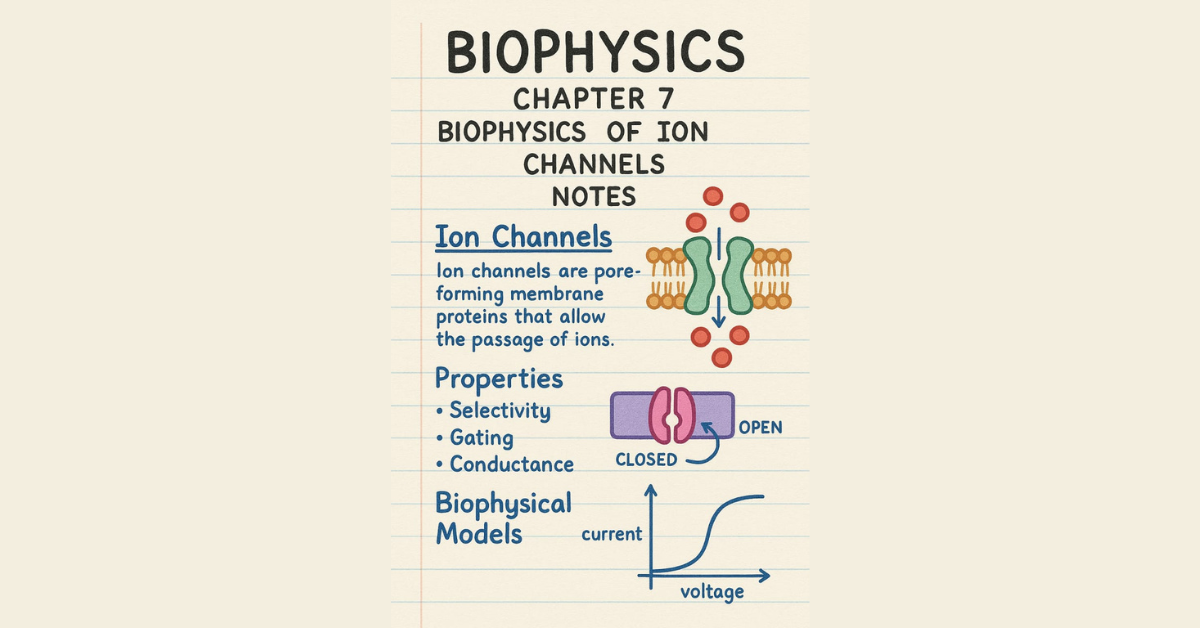Concise Biophysics Chapter 7 Biophysics of Ion Channels Notes
Notes Biophysics Chapter 7 Biophysics of Ion Channels
Ion channels are vital components of cellular membranes, playing a central role in nerve transmission, muscle contraction, cardiac rhythm, and fluid balance. The biophysics of ion channels explores how these tiny protein structures use physical principles to regulate the movement of ions across membranes—ultimately controlling the electrical and chemical signals essential to life.
What Are Ion Channels?
Ion channels are pore-forming proteins embedded in the lipid bilayer of cell membranes. They allow specific ions—such as sodium (Na⁺), potassium (K⁺), calcium (Ca²⁺), and chloride (Cl⁻)—to pass in and out of cells, following their electrochemical gradients.
Unlike passive diffusion through the membrane, ion channels provide a selective and rapid route for ion movement, often regulated by voltage, ligands, or mechanical forces.
Types of Ion Channels
-
Voltage-Gated Channels
-
Open or close in response to changes in membrane potential.
-
Crucial in the generation and propagation of action potentials in neurons and muscle cells.
-
-
Ligand-Gated Channels
-
Activated by binding of specific molecules (e.g., neurotransmitters like acetylcholine).
-
Play a key role in synaptic transmission.
-
-
Mechanically-Gated Channels
-
Respond to mechanical stress or pressure (e.g., in skin, ears, or blood vessels).
-
-
Leak Channels
-
Always open and contribute to the resting membrane potential by allowing constant ion flow.
-
Biophysical Principles Behind Ion Channel Function
Ion channels function according to principles of electrochemical gradients, selectivity, and conductance:
-
Selectivity filter: Each channel allows only certain ions based on size, charge, and hydration energy.
-
Gating: The ability of a channel to open or close in response to stimuli.
-
Conductance: The rate at which ions flow through the channel, influenced by membrane voltage and ion concentration.
The Goldman-Hodgkin-Katz equation and Ohm’s law are often used to describe the ion flow and membrane potentials mathematically.
Clinical Relevance
Understanding ion channel biophysics is essential in medicine and nursing practice:
-
Antiarrhythmic drugs modulate ion channels in the heart to control abnormal rhythms.
-
Local anesthetics like lidocaine block sodium channels to prevent nerve conduction.
-
Diuretics target renal ion channels to manage hypertension and fluid retention.
-
Genetic mutations in ion channels can lead to diseases called channelopathies, including epilepsy, cystic fibrosis, and certain types of paralysis.
Nursing Perspective
Nurses monitor and manage many conditions directly related to ion channel function:
-
Recognizing ECG changes due to altered ion flows.
-
Administering drugs that affect ion transport (e.g., digoxin, calcium channel blockers).
-
Monitoring electrolyte imbalances (e.g., hypokalemia or hypercalcemia) and their effects on muscle and nerve function.
Conclusion
Ion channels are microscopic gatekeepers that regulate vital physiological processes. The biophysical understanding of how they function helps bridge basic science and clinical care, empowering healthcare professionals to better understand drug actions, disease mechanisms, and therapeutic interventions.
Google drive : https://drive.google.com/file/d/1xIairp09EONJbRSTErSzWB0gBJd134pC/view?usp=sharing
Studocu: https://www.studocu.com/row/u/128889758?sid=550504221748700349
Slide Share: https://www.slideshare.net/slideshow/biophysics-chapter-7-biophysics-of-ion-channel-pdf/279961110
Concise Biophysics Chapter 7 Biophysics of Ion Channels Notes
Concise Biophysics Chapter 7 Biophysics of Ion Channels Notes
Read More:
https://nurseseducator.com/didactic-and-dialectic-teaching-rationale-for-team-based-learning/
https://nurseseducator.com/high-fidelity-simulation-use-in-nursing-education/
First NCLEX Exam Center In Pakistan From Lahore (Mall of Lahore) to the Global Nursing
Categories of Journals: W, X, Y and Z Category Journal In Nursing Education
AI in Healthcare Content Creation: A Double-Edged Sword and Scary
Social Links:
https://www.facebook.com/nurseseducator/
https://www.instagram.com/nurseseducator/
https://www.pinterest.com/NursesEducator/
https://www.linkedin.com/in/nurseseducator/
https://www.researchgate.net/profile/Afza-Lal-Din
https://scholar.google.com/citations?hl=en&user=F0XY9vQAAAAJ
